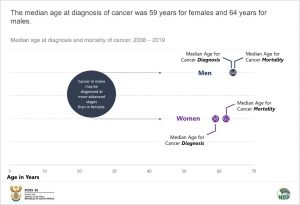Cancer report – A look at the latest findings
In 2018, females accounted for 51,3% of cancers diagnosed in South Africa while males accounted for 48,6%. The median age at diagnosis of cancer was 59 years for females and 64 years for males. However, the median age at death due to cancer was 62 for females and 64 for males, suggesting that cancer in males may be diagnosed at more advanced stages than in females.
These are just some of the findings of a report by Statistics South Africa titled Cancer in South Africa (2008 – 2019), which covers the number of people diagnosed with cancer, as well as those who died from cancer, between 2008 and 2019. Data on diagnosed cases in this report was sourced from the National Cancer Registry of the Department of Health, while data on mortality came from the DHA death register, published by Stats SA as the Mortality and causes of death release.
In South Africa, some groups are at a higher risk of cancer than others due to co-morbidities or because of unequal access to treatment.
Cervical cancer incidence and mortality rates were highest among black African women; this is likely due to late diagnosis or the high burden of HIV in this population group. Women with HIV are much more likely to develop cervical cancer than women without HIV. Nearly all cases of cervical cancer are due to Human papillomavirus (HPV) infection. The sustained rollout of HPV vaccination is therefore important to protect adolescent females from infection with the HPV virus. Cervical cancer can also be prevented by regular pap smears to detect early changes on the cervix that might become cervical cancer if they are not treated appropriately. In resource-constrained areas the National Department of Health recommends alternative screening tests that do not require laboratory facilities.
According to the World Health Organization, the increasing adoption of risky behaviours such as smoking, the harmful use of alcohol, inadequate intake of fibre, fruit and vegetables and lack of physical exercise are major contributing factors for increased risk of cancer.
The highest number of cancers diagnosed among males were prostate, colorectal, lung and non-melanoma skin cancers (basal cell carcinoma and squamous cell carcinoma of the skin). Among females, breast, cervical, colorectal and non-melanoma skin cancers were the most commonly diagnosed cancers.
Between 2008 and 2019, white females had the highest incidence of breast cancer. Their mortality rates, however, were almost the same as those of Coloured females. This suggests that while Coloured females had lower incidence rates they were diagnosed at more advanced stages of the disease, possibly due to poor access to cancer screening, treatment and inadequate knowledge of the signs and symptoms of breast cancer. Awareness of the symptoms of cancer and early detection have been shown to be the main intervention in reducing the risk of breast cancer mortality.
White males had the highest prostate cancer incidence rates, followed by Coloured males, while Black African and Indian/Asian males had lower and almost the same incidence rates. Coloured males had the highest mortality rates, followed by Black African males. This again reflects differences in access to early cancer detection and treatment between population groups.
White males had the highest colorectal incidence rates, followed by Indian/Asian and Coloured males. Black African males had the lowest incidence rates. White males also had the highest colorectal cancer mortality rates, followed by Indian/Asian males and Coloured males, with Black African males experiencing the lowest mortality rates.
Statistics on cancer inform health planning programmes to address the increasing burden of cancer. It assists in the appropriate allocation of resources and aids the implementation of programs aimed at screening, case detection, treatment and preventive services such as Human Papillomavirus (HPV) vaccination for adolescent females to reduce occurrence of cervical and other cancers in their adult years. The information also enables awareness for the creation of programs about the risk factors associated with cancer such as tobacco, harmful use of alcohol, sedentary lifestyles, consumption of high fatty and sugary foods, inadequate intake of fibre, fruit and vegetables, unsafe sexual practices, exposure to high levels of ultraviolet (UV) radiation, pollution and comorbidities such as TB and HIV, which increase the risk of cancer.
For more information, download the full report here.


